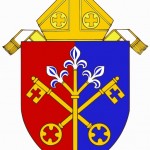 Ask a tourist what is the most familiar statue in St. Peter’s Basilica, and he’s likely to cite Michelangelo’s Pieta. Then, of course, there is the statue of St. Peter, its toe worn smooth by the kisses of devoted pilgrims, and the 140 saints on the colonnade overlooking St. Peter’s Square.
Ask a tourist what is the most familiar statue in St. Peter’s Basilica, and he’s likely to cite Michelangelo’s Pieta. Then, of course, there is the statue of St. Peter, its toe worn smooth by the kisses of devoted pilgrims, and the 140 saints on the colonnade overlooking St. Peter’s Square.
Less obvious, though, are the saints who are honored on the outer walls of the Basilica, where marble statues stand in niches. Some, on the rear walls of the Basilica inside the walls of Vatican City, are rarely seen by tourists. Several niches remain empty, waiting for future saints to take their place in the Basilica’s hallowed walls.
 The most recent saint to find a place of honor on the outer wall is Saint Hannibal di Francia. Hannibal (or Annibale Maria, in Italian) lived in Messina, Italy from 1851 until his death in 1927. Orphaned in early childhood, Hannibal had a great faith. At the age of seventeen, as he knelt in prayer before the Blessed Sacrament, he was given the “revelation of Rogate”; that is, he deeply felt that vocations in the Church come only through prayer. Later on, he found that same message in the Gospel (Mt 9:38, Lk 10:2), where Jesus commands prayer for vocations: “Beg the harvest master to send out laborers to gather his harvest.” These words of Christ became the inspiration for his life.
The most recent saint to find a place of honor on the outer wall is Saint Hannibal di Francia. Hannibal (or Annibale Maria, in Italian) lived in Messina, Italy from 1851 until his death in 1927. Orphaned in early childhood, Hannibal had a great faith. At the age of seventeen, as he knelt in prayer before the Blessed Sacrament, he was given the “revelation of Rogate”; that is, he deeply felt that vocations in the Church come only through prayer. Later on, he found that same message in the Gospel (Mt 9:38, Lk 10:2), where Jesus commands prayer for vocations: “Beg the harvest master to send out laborers to gather his harvest.” These words of Christ became the inspiration for his life.
In 1909, Hannibal wrote a letter to Pope S. Pius X, urging him to call on the faithful to pray for vocations to religious life. Hannibal wrote:
“From my youth I have devoted myself to the words of the Gospel: Pray therefore the Lord of the Harvest…In my charitable institutions, orphans, poor, priests and nuns, all pray incessantly to the loving Hearts of Jesus and Mary, to the Patriarch St. Joseph and to the Apostles, that they may provide the Holy Church with numerous and chosen laborers for the harvest of souls.”
 On January 23, 1964, during the Second Vatican Council, Pope Paul VI established the World Day of Prayer for Vocations. Citing the need for such prayer, the pontiff wrote:
On January 23, 1964, during the Second Vatican Council, Pope Paul VI established the World Day of Prayer for Vocations. Citing the need for such prayer, the pontiff wrote:
“The problem of having a sufficient number of priests has an immediate impact on all of the faithful: not simply because they depend on it for the religious future of Christian society, but also because this problem is the precise and inescapable indicator of the vitality of faith and love of individual parish and diocesan communities, and the evidence of the moral health of Christian families. Wherever numerous vocations to the priesthood and consecrated life are to be found, that is where people are living the Gospel with generosity.”
Since then, every year on the Fourth Sunday of Easter, the Popes call the universal Church to prayer for vocations to the priesthood and religious life.
On April 21, 2013, the Church celebrates the 50th World Day of Prayer for Vocations. The theme for this year’s day of prayer, “Vocations as a Sign of Hope Founded in Faith”, was announced in October 2012 by Pope Benedict, who said:
“Today too, Jesus continues to say, ‘Come, follow me.’ Accepting his invitation means no longer choosing our own path. Following him means immersing our own will in the will of Jesus, truly giving him priority, giving him pride of place in every area of our lives.
“Whenever a disciple of Jesus accepts the divine call to dedicate himself to the priestly ministry or to the consecrated life, we witness one of the most mature fruits of the Christian community.”
Pope Francis, in the early days of his pontificate, has echoed the theme of vocations as a sign of hope. In his homily at the Mass of his Initiation of the Petrine Ministry, Pope Francis spoke of this hope, saying:
“Today too, amid so much darkness, we need to see the light of hope and to be men and women who bring hope to others.”
Here, Pope Benedict blesses the statue of St. Hannibal, which was installed in July 2010 in an exterior niche near the Arch of the Bells.











